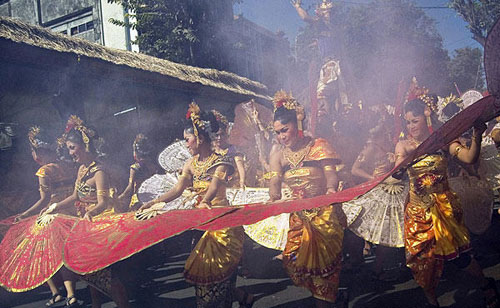 |
|
The Republic of Indonesia, the world's fourth most populous nation, has 203 million people living on nearly one thousand permanently settled islands. Some two-to-three hundred ethnic groups with their own languages and dialects range in population from the Javanese (about 70 million) and Sundanese (about 30 million) on Java, to peoples numbering in the thousands on remote islands. The nature of Indonesian national culture is somewhat analogous to that of India—multicultural, rooted in older societies and interethnic relations, and developed in twentieth century nationalist struggles against a European imperialism that nonetheless forged that nation and many of its institutions. The national culture is most easily observed in cities but aspects of it now reach into the countryside as well. Indonesia's borders are those of the Netherlands East Indies, which was fully formed at the beginning of the twentieth century, though Dutch imperialism began early in the seventeenth century. Indonesian culture has historical roots, institutions, customs, values, and beliefs that many of its people share, but it is also a work in progress that is undergoing particular stresses at the beginning of the twenty-first century.
The name Indonesia, meaning Indian Islands, was coined by an Englishman, J. R. Logan, in Malaya in 1850. Derived from the Greek, Indos (India) and nesos (island), it has parallels in Melanesia, "black islands"; Micronesia, "small islands"; and Polynesia, "many islands." A German geographer, Adolf Bastian, used it in the title of his book, Indonesien , in 1884, and in 1928 nationalists adopted it as the name of their hoped-for nation.
Most islands are multiethnic, with large and small groups forming geographical enclaves. Towns within such enclaves include the dominant ethnic group and some members of immigrant groups. Large cities may consist of many ethnic groups; some cities have a dominant majority. Regions, such as West Sumatra or South Sulawesi, have developed over centuries through the interaction of geography (such as rivers, ports, plains, and mountains), historical interaction of peoples, and political-administrative policies. Some, such as North Sumatra, South Sulawesi, and East Java are ethnically mixed to varying degrees; others such as West Sumatra, Bali, and Aceh are more homogeneous. Some regions, such as South Sumatra, South Kalimantan, and South Sulawesi, share a long-term Malayo-Muslim coastal influence that gives them similar cultural features, from arts and dress to political and class stratification to religion. Upland or upriver peoples in these regions have different social, cultural, and religious orientations, but may feel themselves or be perforce a part of that region. Many such regions have become government provinces, as are the latter three above. Others, such as Bali, have not.
Indonesia consists of all or part of some of the world's largest islands—Sumatra, Java, most of Kalimantan (Borneo), Sulawesi (Celebes), Halmahera, and the west half of New Guinea (Papua)—and numerous smaller islands, of which Bali (just east of Java) is best known. These islands plus some others have mountain peaks of 9,000 feet (2,700 meters) or more, and there are some four hundred volcanos, of which one hundred are active. Between 1973 and 1990, for example, there were twenty-nine recorded eruptions, some with tragic consequences. Volcanic lava and ash contributed to the rich soils of upland Sumatra and all of Java and Bali, which have nurtured rice cultivation for several thousand years.
The inner islands of Java, Madura, and Bali make up the geographical and population center of the archipelago. Java, one of the world's most densely settled places (with 2,108 people per square mile [814 per square kilometer] in 1990), occupies 78 percent of the nation's land area but accounts for about 60 percent of Indonesia's population. (About the size of New York state, Java's population is equivalent to 40 percent of that of the United States.) The outer islands, which form an arc west, north, and east of the inner ones, have about 90 percent of the land area of the country but only about 42 percent of the population. The cultures of the inner islands are more homogeneous, with only four major cultural groups: the Sundanese (in West Java), the Javanese (in Central and East Java), the Madurese (on Madura and in East Java), and the Balinese (on Bali). The outer islands have hundreds of ethnolinguistic groups.
